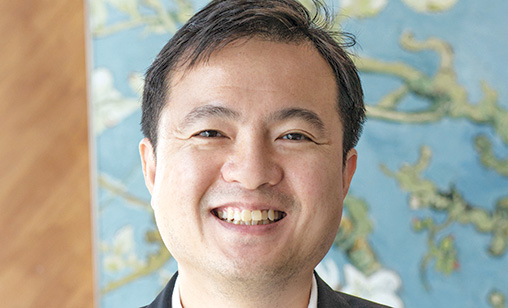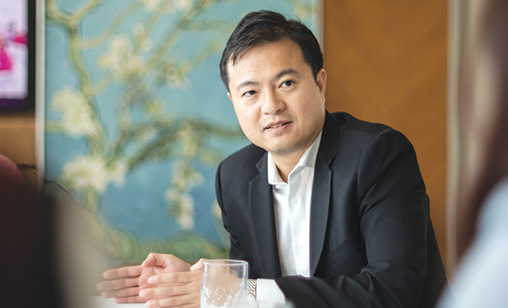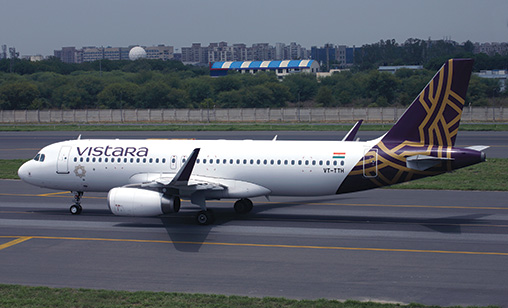Cover Story
Vistara’s market grab
In a year of turbulent skies in India, full-service Vistara has accelerated its expansion to exploit the capacity gap left by the collapse of rival, Jet Airways. Associate editor and chief correspondent, Tom Ballantyne, reports from Singapore.
September 1st 2019
August was a landmark month for Vistara’s Leslie Thng and his team at the Indian joint venture carrier. Read More » At just under five years old, the Tata-Singapore Airlines airline operated its inaugural international flight, from Delhi to Singapore, on August 7 while developing at the same time a fleet and partnership expansion that was unthinkable for the Gurgaon-headquartered carrier as recently as 12 months ago.
“From today onwards,” Thng declared in Singapore, “Indian aviation will have a new symbol of the finest modern Indian hospitality in global skies with Vistara. As an Indian airline with a contemporary global outlook, Vistara is committed to making India proud in world aviation.”
 |
That is not just marketing speak from the CEO of India’s newest international entrant - 51%-owned by Indian conglomerate, Tata Group, and 49% by Singapore Airlines (SIA). Thng is explaining his plans for the carrier to swoop on opportunities to expand created by the grounding and bankruptcy of full-service rival, Mumbai-based Jet Airways.
Vistara presently has a local market share of 5%. Its foreign airline rivals include market leader, Emirates Airline, at 14.6% followed by Etihad (6.2%).
“If you look at the end of the last financial year, which was March 31, we were 22 aircraft (A320-200s and A320neo). Now, we are 30 aircraft. In the span of a couple of months we have brought in eight aircraft,’’ Thng said at a media briefing after the inaugural flight touched down in Singapore.
“It started at the end of May when we decided to introduce a different aircraft type into our fleet - the 737-800NG. We inducted the first 737 on May 3. From then until the end of July, we took in six 737s and then another one in early August. These are former Jet [Airways] 737s we are leasing from the respective lessors. Altogether, we have committed to nine 737s.
“In terms of expansion, we grew quite a lot in the last three months. That was, of course, because of the state of play in India where one airline’s operations were suspended. There was a need to restore some of the capacity, especially full-service capacity.
“Back then, three months back, we decided the most effective way to increase capacity was to bring in the 737, which is readily available in the Indian market. The crew required to operate the 737, whether it was the tech crew or cabin crew, also were available. We recruited almost 600 former Jet employees to Vistara in a month.” New joiners included more than 100 pilots and 300 cabin crew trained to operate 737s.
Thng holds a Bachelor Degree in Business Administration from the National University of Singapore and began his career with Singapore Airlines in 1999. A former chief executive of SIA regional subsidiary, SilkAir, he took charge of Vistara in October 2017, succeeding Vistara’s founding CEO, Yeoh Phee Teik.
“When I say we have 30 aircraft, if you fast forward to the end of this calendar year we will be looking to take delivery of another two 737s and nine more A320neos, which will increase our fleet to 41 aircraft, almost double that of March 31 this year. You can see we are growing very aggressively. Expanding very fast.”
| LCCs versus Vistara India’s domestic market is dominated by LCCs, but Thng is adamant Vistara will not be engaging in direct and costly competition with them. “International operations will be a different ball game for Vistara,” he said. “On the domestic front, it is what it is. With international operations we would like compare and compete with the major players, whether it is SIA, Cathay Pacific or Thai Airways. “Low-cost will always be there for international, but we are going after a different market sector. What we want to achieve in the shortest possible time is to repeat what we did in the local market. We are the finest of the best Indian carriers.” |
At the same time as the 737s were joining Vistara, Thng and his team were preparing for the launch of the airline’s international flights, a process that required a different mindset, a different product and a different strategy, Thng said.
“It is not a walk in the park. It is a lot of co-ordination and a lot of planning. In the last couple of months, as we focused on expanding the domestic network, another team was working out how quickly we could do international,” he said.
“For an airline as young as Vistara to do four international launches in August, starting with Delhi-Singapore, then Bombay-Singapore, Bombay-Dubai on August 24 and Delhi-Bangkok on August 27, with all the necessary approvals and product for the international operations on the different routes, was a significant achievement for my colleagues at Vistara.”
Vistara’s finances remain in the red, although its annual net loss improved from US$77.9 million in its 2017 year to $64.8 million in 2018, the latest Tata Sons annual accounts reported. Thng said: “We are still not profitable, but we are heading in the right direction to profitability. As to how soon we can be in the black, it is a constant update that I would need to give to shareholders.”
Thng said it is unlikely the two shareholders will need to inject more funds into the carrier.
 |
“Vistara is more focused on organic growth funded by the two shareholders. We have done our sums for the nine aircraft to which we have committed and are quite confident we can manage with what we have now. If we need to do a lot more then it is a different sum that we will have to evaluate. We do not think it is too much of a difference because financially performance is better than last year,” he said.
Thng said the macro-economics of the Indian aviation ecosystem were “very challenging”, whether it is high taxation or high infrastructure costs. “The government is fully aware of the situation. It is considering a preview of policies and initiatives and also dialogues with stakeholders to improve the aviation operating environment,” he said.
“In its budget references to the industry, the government said it wanted India to be a global aviation hub. If you want to be a global aviation hub then the policies supporting Indian aviation have to be more progressive. They have to be reviewed and changed.
“I think government is trying to take care of that part. As for airlines, it is our responsibility to look into our own business model and cost structure. Vistara is a full-service carrier. Our cost structure is very different to low-cost airlines. Having said that, there is a market for full-service airlines domestically, especially between the metros and from metros to the big cities. It is the trend of the last four years.”
Thng said whatever the differences between domestic and international flying, at Vistara they are closely linked. “Vistara will be a global international player but domestic is equally important. We need the domestic feed to support our international growth. At the same time, we must have an extensive network to form partnerships with other foreign carriers,” he said.
The airline operates code-shares with SIA, Japan Airlines, British Airways and United Airlines. There will be other partners, Thng said. Providing a dense domestic network attractive to foreign airline partners is crucial to Vistara’s future, he emphasized. An example of addressing this strategy is an increase in daily flights out of Bombay from 11 to 38 last month.
Entry into international skies is allowing Vistara to put its code on international airline partner flights. SIA previously had its code on Vistara domestic flights but Vistara could not do the same on SIA flights. Now it can. An extended code-share agreement with SIA will see the Vistara code on 44 SIA destinations across ten countries: the U.S., Australia, New Zealand, Japan, Taiwan, Malaysia, Indonesia, Thailand, Vietnam and Cambodia.
“That is the start with one airline. We also are in talks to put our code on other airlines’ international sectors. India is a very big market. It’s a very big source market. We believe we need a partner in every region where we fly,” Thng said.
| Dreamliners to open Europe to Vistara “In a nutshell, we have a plan for increasing our international network, although this year the focus mainly will be Southeast Asia, the Middle East and countries in South Asia. However, the B787s will begin delivery in the first quarter of 2020. We are talking about six months away. “In six or seven months Vistara will be able to start long-haul, if we want to, from day one to let’s say to Europe. We could start India to Europe because we will have the aircraft, the Dreamliners,” Thng said. |
“SIA is a natural fit for Southeast Asia, even Australia, although we have our own plans to fly to Australia. But if we go to Europe, North Asia or the U.S. we will not have SIA to provide us with connectivity. There will be other airlines that will provide the connectivity.”
To support international growth, Vistara intends to expand its domestic reach. “We are just 24 destinations within the country. The country is big enough. The population is big enough. There is nothing stopping us from going to 40 or 50 destinations. But we have to make it relevant for the full-service product that we want to offer,” he said.
“We have to be dense enough to provide the frequency business travelers want, the connectivity to our own international flights and the connectivity to our airline partners who want to be with us. Airline partners will see value in how we serve India and how we serve South Asia. We will see value in the range of connectivity they can give us beyond our on-line points into the country.
“If we do go to Europe, we need a partner who can give us connectivity to 40 or 50 points within Europe. When we look at partners, I am sure they will be looking to Vistara for connectivity and the benefits customers can be offered.”
Europe is far from being a distant dream. Vistara ordered 56 aircraft last year. “Our surrounding countries, where we can fly the A320neo for up to four or five hours, will continue to give us our network for international expansion. At the same time, we have factored in expansion beyond traditional narrow-body operations,” said Thng.
“The A321 offers maybe another hour or so in range, but the 787-9 is the one that provides us with a lot of flexibility. From Delhi or Bombay we can go to Europe non-stop. We can go to North Asia non-stop. The 787-9, depending on how the aircraft is designed and configured, can fly from Delhi to Australia and the U.S. non-stop.”
 |
Opening European routes will put Vistara in direct competition with Emirates and Etihad and some smaller Middle Eastern carriers. They offer very cheap fares from India and onto Europe via their home hubs.
“How long will it take for Vistara to become one of the best in the global arena? It is what we have set out to do. If you want to achieve that goal, you should be competing against the big players. You should make sure that your product, your service and, to a certain extent, your cost structure is aligned so you can offer reasonable fares to the consumer. This is our intention,” Thng said.
Thng does not believe Vistara’s rapid domestic expansion threatens the airline’s long-term viability. “After the suspension of Jet, the proportion of full-service capacity in the domestic market and the international market shifted. On the domestic front, LCC penetration has increased because at this moment we are about 5% of the market share. Air India would be less than 20%. The market was dominated by low-cost,” he said.
‘But India is a market that is growing. The demand for premium product will continue to grow and there is a gap we are trying to fill in the market [since Jet’s grounding]. Although we are bringing nine more aircraft into our fleet, considering the bigger picture, we have not really done that much.
“Similarly, at international, there is quite an extensive international footprint. We are still trying to recover some of it. I don’t think we have overdone it. There is a lot more we can do. If you look at the entire full-service capacity of Indian carriers versus foreign carriers, there is a big gap. We need to catch up.”
Interestingly, Thng is not averse to reviewing strategies intended to make the carrier more competitive. “Where you used to think you could apply a one size fits all approach, where we used to have only a three-class cabin – business, premium economy and economy – to serve all the Indian domestic market we are asking if that is still relevant,” he said.
“Is it still suitable given the diversity of the market across the country? The economies of certain states can provide demand for a premium product. In certain states we are ahead of the curve. We are readjusting some of the product offering.
“But the business model will be full-service whether passengers fly on a three-class aircraft, two-class on the 737 or if we introduce an all-economy product. Depending on the point that we serve, if we decide the market is mainly or predominantly economy class then it is likely we will operate a single class all-economy product on these routes.
“It does not mean all-economy is low-cost. You will still enjoy a full-service product, but there will not be options of business and premium economy available because the demand is not there - at the moment. We are adjusting strategies to make sure we are more relevant to specific markets.”
Vistara has a lot of competition, particularly from the Gulf carriers that offer low fares for full service flights. Will Vistara continue to operate a dual single-aisle fleet – A320s and 737s – over the longer term? “That remains to be seen. The arrival of Jet’s 737s was opportunistic. They are on short-term leases of one to four years. “We will review them later on,” Thng said.
“We made the decision to do a dual fleet because of recent events. Going forward, we will decide on a dual fleet or a single fleet, depending on the scope of expansion.
“I believe if we have a decent size there is nothing to stop you operating a dual fleet as long as you extract good economics from it. There will be some inefficiency in MRO and the commonality of cockpits, but if you do your sums and it makes sense, why not?
“Right now, we are continuing with the dual fleet, at least for the next one to four years. Definitely, we will review it when we need to commit ourselves to another aircraft order. The order we did last year only covers us to 2023.
“Vistara will not stop growing. We are in constant dialogue with the aircraft manufacturers. It depends on the offer they make to us. When we need to order to accelerate beyond 2023, we will do it at an appropriate time.”
“This is just the start,” Thng said. “We will not stop. There is more we want to do and that is why we have ordered 56 aircraft. It depends on opportunities in the market or if we can grow faster and expand more aggressively than we envisaged last year.
“It was never planned to have a dual fleet of narrow bodies. But if it helps Vistara accelerate growth, we will do it.”